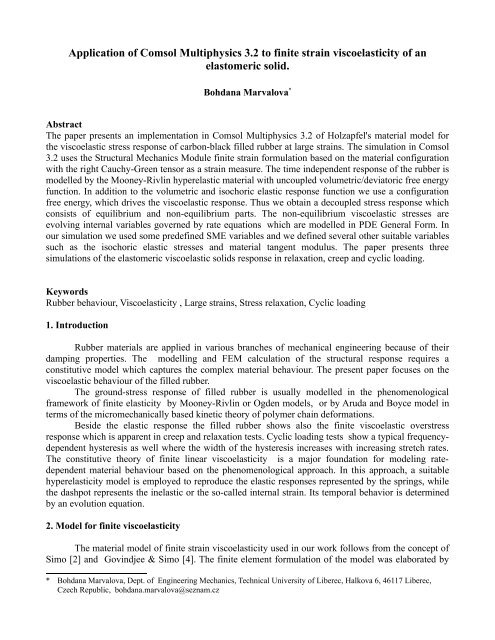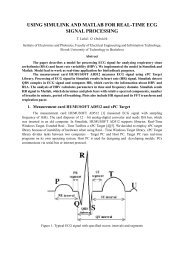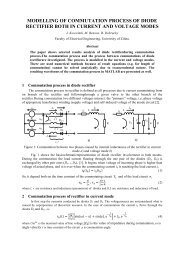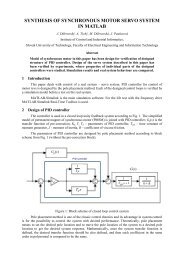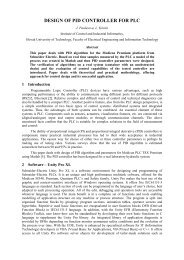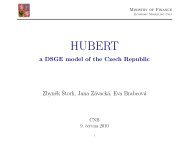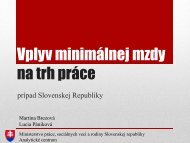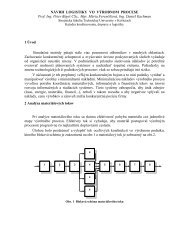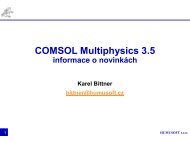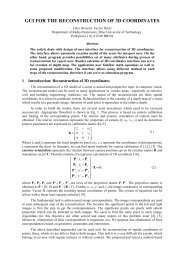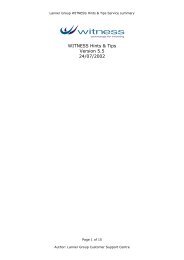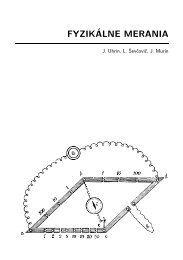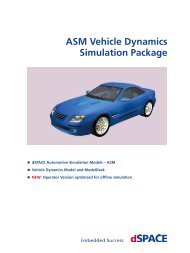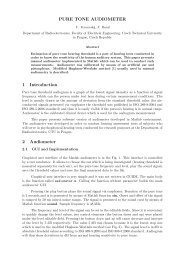Application of Comsol Multiphysics 3.2 to finite strain ... - Humusoft
Application of Comsol Multiphysics 3.2 to finite strain ... - Humusoft
Application of Comsol Multiphysics 3.2 to finite strain ... - Humusoft
You also want an ePaper? Increase the reach of your titles
YUMPU automatically turns print PDFs into web optimized ePapers that Google loves.
<strong>Application</strong> <strong>of</strong> <strong>Comsol</strong> <strong>Multiphysics</strong> <strong>3.2</strong> <strong>to</strong> <strong>finite</strong> <strong>strain</strong> viscoelasticity <strong>of</strong> anelas<strong>to</strong>meric solid.Bohdana Marvalova *AbstractThe paper presents an implementation in <strong>Comsol</strong> <strong>Multiphysics</strong> <strong>3.2</strong> <strong>of</strong> Holzapfel's material model forthe viscoelastic stress response <strong>of</strong> carbon-black filled rubber at large <strong>strain</strong>s. The simulation in <strong>Comsol</strong><strong>3.2</strong> uses the Structural Mechanics Module <strong>finite</strong> <strong>strain</strong> formulation based on the material configurationwith the right Cauchy-Green tensor as a <strong>strain</strong> measure. The time independent response <strong>of</strong> the rubber ismodelled by the Mooney-Rivlin hyperelastic material with uncoupled volumetric/devia<strong>to</strong>ric free energyfunction. In addition <strong>to</strong> the volumetric and isochoric elastic response function we use a configurationfree energy, which drives the viscoelastic response. Thus we obtain a decoupled stress response whichconsists <strong>of</strong> equilibrium and non-equilibrium parts. The non-equilibrium viscoelastic stresses areevolving internal variables governed by rate equations which are modelled in PDE General Form. Inour simulation we used some predefined SME variables and we defined several other suitable variablessuch as the isochoric elastic stresses and material tangent modulus. The paper presents threesimulations <strong>of</strong> the elas<strong>to</strong>meric viscoelastic solids response in relaxation, creep and cyclic loading.KeywordsRubber behaviour, Viscoelasticity , Large <strong>strain</strong>s, Stress relaxation, Cyclic loading1. IntroductionRubber materials are applied in various branches <strong>of</strong> mechanical engineering because <strong>of</strong> theirdamping properties. The modelling and FEM calculation <strong>of</strong> the structural response requires aconstitutive model which captures the complex material behaviour. The present paper focuses on theviscoelastic behaviour <strong>of</strong> the filled rubber.The ground-stress response <strong>of</strong> filled rubber is usually modelled in the phenomenologicalframework <strong>of</strong> <strong>finite</strong> elasticity by Mooney-Rivlin or Ogden models, or by Aruda and Boyce model interms <strong>of</strong> the micromechanically based kinetic theory <strong>of</strong> polymer chain deformations.Beside the elastic response the filled rubber shows also the <strong>finite</strong> viscoelastic overstressresponse which is apparent in creep and relaxation tests. Cyclic loading tests show a typical frequencydependenthysteresis as well where the width <strong>of</strong> the hysteresis increases with increasing stretch rates.The constitutive theory <strong>of</strong> <strong>finite</strong> linear viscoelasticity is a major foundation for modeling ratedependentmaterial behaviour based on the phenomenological approach. In this approach, a suitablehyperelasticity model is employed <strong>to</strong> reproduce the elastic responses represented by the springs, whilethe dashpot represents the inelastic or the so-called internal <strong>strain</strong>. Its temporal behavior is determinedby an evolution equation.2. Model for <strong>finite</strong> viscoelasticityThe material model <strong>of</strong> <strong>finite</strong> <strong>strain</strong> viscoelasticity used in our work follows from the concept <strong>of</strong>Simo [2] and Govindjee & Simo [4]. The <strong>finite</strong> element formulation <strong>of</strong> the model was elaborated by* Bohdana Marvalova, Dept. <strong>of</strong> Engineering Mechanics, Technical University <strong>of</strong> Liberec, Halkova 6, 46117 Liberec,Czech Republic, bohdana.marvalova@seznam.cz
Holzapfel [3] and used by Holzapfel & Gasser [5] <strong>to</strong> calculate the viscoelastic deformation <strong>of</strong> fiberreinforced composite material undergoing <strong>finite</strong> <strong>strain</strong>s.The model is based on the theory <strong>of</strong> compressible hyperelasticity with the decoupledrepresentation <strong>of</strong> the Helmholtz free energy function with the internal variables (Holzapfel [1], p. 283) :C , 1,..... , m= ∞VOL J ∞ISOmC ∑ C , , C= J −2/3 C . (1)The first two terms in (1) characterize the equilibrium state and describe the volumetric elastic responseand the isochoric elastic response as t ∞ , respectively. The third term is the dissipative potentialresponsible for the viscoelastic contribution. The derivation <strong>of</strong> the 2 nd Piola-Kirchh<strong>of</strong>f stress withvolumetric and isochoric terms:∞S VOL∞S ISOS=2 ∂ C , 1 , ..... , m ∂C=1=S ∞VOLS ∞ISOm∑=1Q (2)where and is the volumetric and the isochoric stress response respectively and theoverstress Q is stress <strong>of</strong> 2 nd Piola-Kirchh<strong>of</strong>f type.S ∞ISOS ∞VOL=J d ∞VOLd J J C −1 ,=J −2/ 3 Dev [2 ∂ ∞ISO∂ CC ] ,Dev .=.−1/3[ .:C ]C −1 . (5)(3)(4)where Dev . is the devia<strong>to</strong>ric opera<strong>to</strong>r in the Lagrangian description. Motivated by the generalizedMaxwell rheological model (Fig. 1), the evolution equation for the internal variable Q takes on theform (6).Fig. 1. Maxwell rheological modelṠ ∞ISOQ˙ Q =Ṡ ISO,Ṡ ISO= ∞Ṡ ∞ ISOC ,whereC = ∂ S ∞ISO∂ C Ċ =C Ė ISOC ISO=2 ∂ S ∞ISO∞∂ C =2 ∂ S ISO∂C∂C∂C(6)(7)(8)(9) ∞ ∈0,∞ in the expression (7) is the nondimensional <strong>strain</strong> energy fac<strong>to</strong>r [2,4], is therelaxation time, C ISO is isochoric contribution <strong>of</strong> the tangent elasticity tensor and Ė is the material<strong>strain</strong> rate tensor
Ė= 1 2 ˙ F T FF T Ḟ .(10)The material is assumed slightly compressible, the volumetric and isochoric (Mooney - Rivlin) parts <strong>of</strong>Helmholtz free energy function were chosen in the form ∞ VOL J = 1 d J −12 , ∞ ISOC =c 1 I 1−3c 2 I 2−3, (11)with the parameters c 1,c 2 and d. The viscoelastic behavior is modeled by use <strong>of</strong> =2 relaxation∞processes with the corresponding relaxation times and free energy fac<strong>to</strong>rs . All theparameters were determined from experimental measurements.3. Finite element simulation in <strong>Comsol</strong> <strong>Multiphysics</strong>The material model described above was implemented in<strong>to</strong> <strong>Comsol</strong> <strong>Multiphysics</strong>. TheStructural Mechanics and PDE modules were used for the calculation <strong>of</strong> time dependent response <strong>of</strong> arubber block in plain <strong>strain</strong> in different loading regimes. The implementation is very similar <strong>to</strong> theViscoelastic material case in Structural Mechanics Model Library. The application mode type plane<strong>strain</strong> in Structural Mechanics Module, the time dependent analysis and the Mooney-Rivlinhyperelastic material were chosen. The components <strong>of</strong> the isochoric stress rate were determinedin Symbolic Toolbox in Matlab and added <strong>to</strong> the scalar expression table in <strong>Comsol</strong>. PDE module wasused for the integration <strong>of</strong> the evolution equation (6). The results <strong>of</strong> the different simulations show thegood qualitative agreement with experimental time dependent behaviour <strong>of</strong> filled rubbers. The similarmodel based on Prony series was implemented in<strong>to</strong> ANSYS 10 [6] and the results <strong>of</strong> simulations arecomparable with our ones.∞Ṡ ISOFig. 2. Time dependent displacement controled loading <strong>of</strong> rubber block
Fig. 3. Creep testFig. 4. Relaxation test4. ConclusionThe paper has presented the FEM implementation in <strong>Comsol</strong> <strong>Multiphysics</strong> <strong>of</strong> a viscoelasticmaterial model in <strong>finite</strong> <strong>strain</strong> in the Lagrangian configuration. Simple examples were subsequentlypresented, namely the relaxation, creep and time dependent loading <strong>of</strong> a rubber block. The block wasmodelled using Structural Mechanics and PDE modules.AcknowledgementThe author gratefully acknowledges the funding provided by the Czech Grant Agency GACR – grantNo.101/05/2669.References[1] Holzapfel, G. A., Nonlinear solid mechanics. Wiley, 2000., ISBN 0471823198[2] Simo, J.C., On a fully three dimensional <strong>finite</strong> <strong>strain</strong> viscoelastic damage model: formulation andcomputational aspects. Comput. Meth. Appl. Mech. Eng. 60 (1987), 153–173.[3] Holzapfel, G.A., On large <strong>strain</strong> viscoelasticity: continuum formulation and <strong>finite</strong> elementapplications <strong>to</strong> elas<strong>to</strong>meric structures. Int. J. Numer. Meth. Eng. 39 (1996), 3903–3926.[4] Govindjee, S., Simo, J.C., Mullins' effect and <strong>strain</strong> amplitude dependence <strong>of</strong> the s<strong>to</strong>rage modulus.Int. J. Solid Struct. 29 (1992), 1737–1751[5] Holzapfel, G. A., Gasser, T.C., A viscoelastic model for fiber-reinforced composites at <strong>finite</strong> <strong>strain</strong>s:Continuum basis, computational aspects and applications. Computer Methods in Applied Mechanicsand Engineering Vol. 190 (2001) 4379-4430[6] Dokumentation for ANSYS 10, verification manual, VM 234


